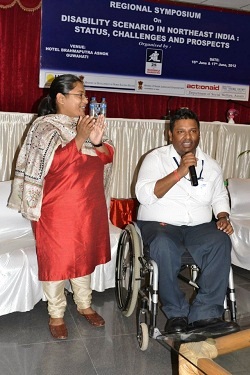Photo by Tshetsholo Naro (Alo)
Conservation of forests is the most happening thing in India today. Vast expanse of forest areas are marked as wildlife sanctuaries, reserved forests and national parks. These areas are spread across India where wilderness can be experienced through the wildlife. Forests have been home to many species of flora and fauna. In the North East Region of India forests are the lifelines of not only the wild animals and plants but also of the diverse communities who lives within and around these forests sustaining them since ages. Concept of conservation in the tribal ethics of communities living in the fringes of forests is very dynamic. Conservation is equated with regeneration naturally after sustained equitable use of the forest resources which is shared between the human and natural world. Conservation does not happen in isolation, away from the forest dependent communities. In Nagaland, villages are proud owners of forest areas through collective identities. One forest does not belong to one individual, family, clan or tribe but they are shared. Lives and livelihoods depend on the forest resources.
Hunting has been a tradition and way of life for Nagas. It is a process of socialization and identity formation for youth especially for boys and men. Sometimes even the family traditions and ancestral fame of being astute hunters compel young people to live up to the expectations of the family and community elders. Hunting is considered a sport and living passion which depicts machismo and establishes the fact that humans can rule nature. In olden time’s recognition, fame and wealth and honour was associated with people who can hunt. Hunting defined human valour which earned rich rewards. People depending on hunting lived frugal lives with very basic entitlements. Needs were low and people could survive with bare minimum. Forests could provide for all the elementary needs. In recent times needs have increased and forests have shrinked.
Communities have started having growing individual needs which cannot be sustained through forests. The time cycle for regeneration has become smaller resulting in barren lands, degraded forests and loss of wildlife habitat. This has an adverse impact on both nature and humans. Constant conflicts of nature in the form of epidemics, disease, landslides, earthquakes and disasters have left humans bereft of any natural resources. There is a constant struggle for space and liquid cash which can come only through illegal trade of natural resources. Many varieties of natural flora and fauna have gone extinct in this struggle for survival in Nagaland. Food choices have become limited and suddenly the exotic flavours were drawn from the most endangered species of birds and animals. It became a hunter’s delight to get the most exotic varieties to the market for the maximum price that the wild product could fetch. But this form of hunting was for survival not necessarily for passion or pride only.
Hunters have a deep bond with the forest. They are alert and aware of their natural surroundings and hence they can communicate in the language of the wild. Hence when Hollock Gibbon Eco Club began to engage with the conservation work in some of the wildest community forests in Chizami village cluster in Nagaland, they approached the hunters. They organized series of workshops on environment awareness and sustainable conservation practices which benefitted the communities and nature along with young hunters who otherwise go to school also. This experiment was spearheaded by North East Network in Nagaland with some experienced wildlife experts from across the country.
When I visited Chizami in the month of June this year for my field research, I met two young boys who are hunter-turned-conservationists. They helped me to understand the forest area which surrounds the village community. The forest belongs to each and every member of the village. No one person owns it but all the members can access the forest for their own need. Faith, beliefs and some rituals do bind the communities to respect the forest but gradual shift from hunting to conservation of the natural resources has brought back many species of birds back to the forest area. In olden times, birds were sacrificed to follow socio-cultural and religious norms but soon human greed wiped out the bird population in this region. But it was really encouraging to hear chirpings once again.
The young Green Ambassadors as they called themselves were very excited to show the forest to me and another student who travelled with me into the wild. While trekking through the forest trail, they showed us various fruit trees which were planted by them at some point of time and now they have grown much taller. They showed us a Jhum field in the heart of the forest and counted some 18 varieties of crops, creepers, tubers, roots and plants which were part of human and tamed animal diet. This was indeed an excellent example of agro-ecology which was home to organic and traditional seed varieties.
I was amazed to see the alertness of these young people who managed to guide us slowly through the forest. Since it was late afternoon and raining, they gave us a choice in the middle of the forest whether we would continue the trail or should we return. We decided to go through the forest which meant crossing the slope of an entire hill and walking through the dense forest. There were leeches on the way, one of them reached my naval when I could realize its presence. With great effort I could remove it gradually.
The youths knew each and every turn of the forest. At one moment they became very alert, I wondered if it was any wild animal, but they showed me some uprooted plants. They said it was Ginseng a plant found abundantly in these forests. It is called Panax Assamias which is used as a tonic and vitalizer by local herbs practitioners. It sells for Rs 1000/ kg in Dimapur and Kohima markets. Another such plant is Paris Polyphylla which is used in Chinese medicine for its anti-cancer properties. The dry rhizomes of this plant are also sold to Myanmar between Rs 500-700 per kg. But we were not sure which plant was extracted from this forest, but one of these plants was available here. There is a ban on the procurement of this plant due to unknown reasons. But most of the roots of these plants are traded illegally for very high price to foreign nations. It seems this plant has some anti-aging elements which are used by drug companies to promote pharmaceutical products.
While coming down the slope of the forest, I had to slide on my backside to maintain balance as it was very steep. But the leaf fall on the slope was so thick that I did not have much problem in doing so. These Green Ambassadors led the way through the forest and finally we reached the village pond which was actually a wonderful catchment area for water. There was a village legend that this pond had the spirit of a girl who loved a boy in the village. Somehow they got separated and they lived in two different ponds even now. I was very intrigued by these community legends and felt very nostalgic to find the stories of love connected to nature and probably that’s why the pond is still surviving at a height of 5000 meters above sea level. In our country natural world has been sustained by people and the power of faith more than by regulations, laws and manicured conservation projects.
It is time that we respect the call of nature which accepts humans as they are, whether humans are exploitative, conservationists or ecologists. But as humans we want the natural world to be as it should be for us concrete, composed and crafted. Somewhere this equation of conservation and development cannot be resolved with one variable. It needs many variables which have to ensure that the natural and human world draws a middle path for a sustainable future.







































